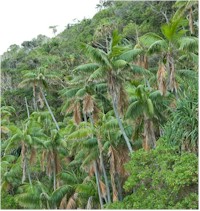| . | |
Kentia |
|
| . | |
|
|
|
| . | |
| About Kentias § Kentia Care | ||
| . |
 |
|
| . | ||
| . | About Kentias:- | |
| . | ||
| . | The Kentia Palm - Howea forsteriana - is a member of the Palm family. They originates from the Lord Howe Island, a little bit of paradise east of Australia. As they start their life as seedlings growing beneath the foliage of larger trees, these natural growing conditions ensure that Kentias are adapted to low light, low humidity and cool conditions. Howea is a genus of two palms, H. belmoreana and H. forsteriana, both endemic to Lord Howe Island - Wikipedia - Howea. Kentias grow to 12 meters in their natural habitat, but, as they are are slow growers, they are ideal for indoors. | |
| . | ||
| . | The Kentia Palm is ideal for bringing green life into your personal space at the office or in your home. They produce elegant dark green palm leaves in the shape of a slender fountain. The quite dense foliage improves the quality of the air in, whilst still allowing diffuse light into, your room. Importantly, Kentia palms are pet-friendly. A well cared for Kentia palm can live for 50 years! | |
| . | ||
| . | Queen Victoria loved Kentia Palms and she grew them in all her palaces.
This association with royalty earned the palm prestige in society. |
|
| . | Due to their photogenic qualities, Kentia Palms are also known as "The Hollywood Palm" and frequently star in movies and TV show. | |
| . | ||
| . |
 |
|
| . | ||
| . | ||
| . | ||
| . | Kentia Care:- | |
| . | ||
| . | Light: | |
| . | Kentias prefer being away from any windows that let in direct midday sunlight as their leaves will "burn". If the leaves turn pale green to yellow, they are receiving too much light. If they developing very few new shoots, they aren't receiving enough light. Kentias thrive under "Goldilocks" light conditions - not too bright, not too dark.... | |
| . | ||
| . | Temperatutre: | |
| . | Kentia Palms love room temperature and even slightly warmer. Below 10°C is too chilly and they shouldn't be exposed to these temperatures for any length of time. | |
| . | ||
| . | Watering:- | |
| . | Kentias prefer slightly damp soil, but not "wet feet" -
ensure that their roots are not sitting in a pool of water (unless they
are grown and maintained hydroponically). Ideally they should be watered
well when the soil starts becoming dry and then the pot should be
allowed to drain out the excess. This is not always possible in office
conditions and maintenance should, therefore, be carried out by those
with "Green Fingers". Kentias love a misting every few days during their growing season. Ideally, combine this with a liquid folia feed. Placing them outside in a light rain shower will refresh the plant and assist with red spider mite control. Water less frequently in winter |
|
| . | ||
| . | Nutrition:- | |
| . | Feed Kentias with high quality, well balanced plant food
every two weeks in early Spring through to late Summer. A nutrient-dense
house plant specific liquid fertiliser is perfect for feeding Kentia
palms. Alternatively, a slow-release fertiliser with an NPK ratio of
about 3-1-2 will keep Kentias thriving. Ensure you follow the
manufacturer’s instructions - if in doubt, try a diluted mixture at
first. If using an organic fertiliser (try not to) use at 50%
recommendation Kentia Palms do not grow in winter and, therefore, do not require feeding during this period. |
|
| . | ||
| Repotting:- | ||
| Repot kentia whenever they get "root bound" - the existing pot is more root than soil. This will vary depending on watering techniques, local environment. | ||
| Trouble shooting:- | ||
| Brown tips:- Maybe too much direct sunlight or lack of foliage moisture. Solution:- Move away from midday sunlight, spray foliage once per week in warm seasons. | ||
| Brown foliage:- This is natural, older leaves will turn brown and drop off. Remove to divert energy into new leaves. | ||
| Slow / no growth:- More sunlight required - reminder - no growth in the cold seasons. | ||
| Brown patches:- Possibly fertiliser burn. Always stick with the suppliers directions. | ||
| Yellowing leaves:- Overwatering or cold. Refer temperature & watering above. | ||
| Mould on top soil:- Caused by local moisture - not a problem. Remove by scraping off and spread cinnamon to reduce re=occurence | ||
| Pest control:- Spider mites and mealybugs are the most common pests. Preventative maintenance by wiping the under leaf with warm water, on a soft sponge, every few weeks. If infestation is noticed, use an oil based product rather that an alcohol based product (alcohol based will dry out the palm fronds). | ||
Dendende, Kentia, Howea Forsteriana |